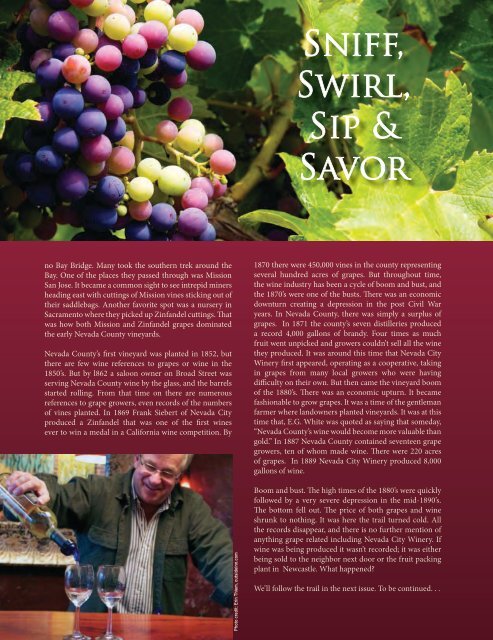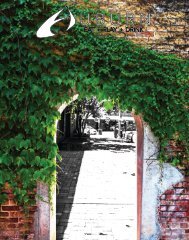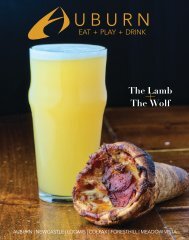Destination Nevada County
Premium visitors magazine for Nevada County produced by the Grass Valley Chamber of Commerce
Premium visitors magazine for Nevada County produced by the Grass Valley Chamber of Commerce
You also want an ePaper? Increase the reach of your titles
YUMPU automatically turns print PDFs into web optimized ePapers that Google loves.
Sniff,<br />
Swirl,<br />
Sip &<br />
Savor<br />
no Bay Bridge. Many took the southern trek around the<br />
Bay. One of the places they passed through was Mission<br />
San Jose. It became a common sight to see intrepid miners<br />
heading east with cuttings of Mission vines sticking out of<br />
their saddlebags. Another favorite spot was a nursery in<br />
Sacramento where they picked up Zinfandel cuttings. That<br />
was how both Mission and Zinfandel grapes dominated<br />
the early <strong>Nevada</strong> <strong>County</strong> vineyards.<br />
<strong>Nevada</strong> <strong>County</strong>’s first vineyard was planted in 1852, but<br />
there are few wine references to grapes or wine in the<br />
1850’s. But by l862 a saloon owner on Broad Street was<br />
serving <strong>Nevada</strong> <strong>County</strong> wine by the glass, and the barrels<br />
started rolling. From that time on there are numerous<br />
references to grape growers, even records of the numbers<br />
of vines planted. In 1869 Frank Siebert of <strong>Nevada</strong> City<br />
produced a Zinfandel that was one of the first wines<br />
ever to win a medal in a California wine competition. By<br />
1870 there were 450,000 vines in the county representing<br />
several hundred acres of grapes. But throughout time,<br />
the wine industry has been a cycle of boom and bust, and<br />
the 1870’s were one of the busts. There was an economic<br />
downturn creating a depression in the post Civil War<br />
years. In <strong>Nevada</strong> <strong>County</strong>, there was simply a surplus of<br />
grapes. In 1871 the county’s seven distilleries produced<br />
a record 4,000 gallons of brandy. Four times as much<br />
fruit went unpicked and growers couldn’t sell all the wine<br />
they produced. It was around this time that <strong>Nevada</strong> City<br />
Winery first appeared, operating as a cooperative, taking<br />
in grapes from many local growers who were having<br />
difficulty on their own. But then came the vineyard boom<br />
of the 1880’s. There was an economic upturn. It became<br />
fashionable to grow grapes. It was a time of the gentleman<br />
farmer where landowners planted vineyards. It was at this<br />
time that, E.G. White was quoted as saying that someday,<br />
“<strong>Nevada</strong> <strong>County</strong>’s wine would become more valuable than<br />
gold.” In 1887 <strong>Nevada</strong> <strong>County</strong> contained seventeen grape<br />
growers, ten of whom made wine. There were 220 acres<br />
of grapes. In 1889 <strong>Nevada</strong> City Winery produced 8,000<br />
gallons of wine.<br />
48 DESTINATION <strong>Nevada</strong> <strong>County</strong><br />
Photo credit: Erin Thiem, outsideinn.com<br />
Boom and bust. The high times of the 1880’s were quickly<br />
followed by a very severe depression in the mid-1890’s.<br />
The bottom fell out. The price of both grapes and wine<br />
shrunk to nothing. It was here the trail turned cold. All<br />
the records disappear, and there is no further mention of<br />
anything grape related including <strong>Nevada</strong> City Winery. If<br />
wine was being produced it wasn’t recorded; it was either<br />
being sold to the neighbor next door or the fruit packing<br />
plant in Newcastle. What happened?<br />
We’ll follow the trail in the next issue. To be continued. . .
















